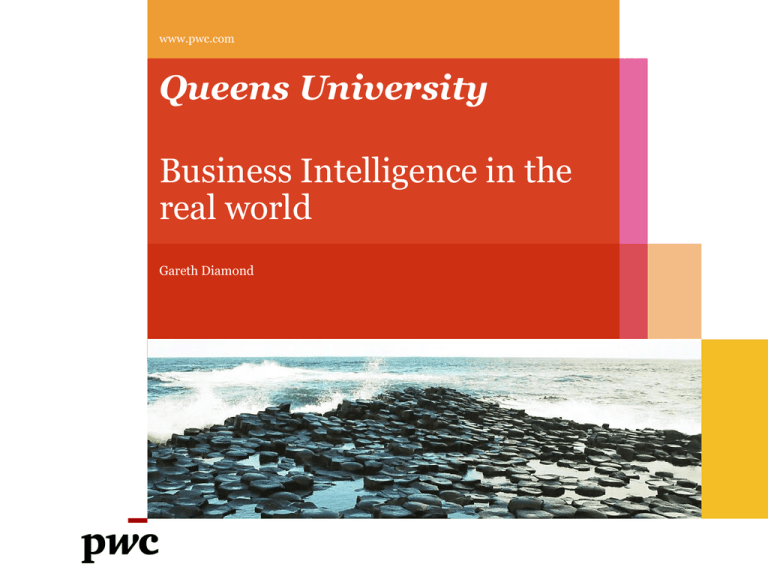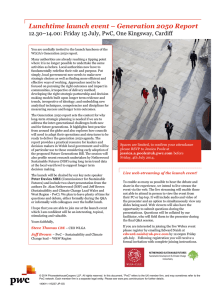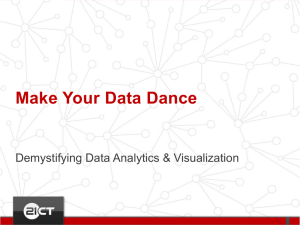
www.pwc.com
Queens University
Business Intelligence in the
real world
Gareth Diamond
Contents
1.
Recap on last week's lecture
2. Key Messages
3. Emerging trends in Business Intelligence
4. How clients are implementing BI to realise value
5. Hype versus reality
PwC
2
1. Covered last week
1.
What is Business Intelligence and Analytics?
2. Why do businesses need BI&A?
In a moment...
3. Business challenges in implementing BI
4. BI isn’t new, so what’s different?
PwC
3
2. What is Business Intelligence and Analytics?
• BI&A is the collective term for
strategies, methods and tools that
empower an organisation to unlock
value from their data.
• It is the key to an organisation
making better decisions using relevant,
reliable and timely data.
Enterprise
Reporting
Data Mining
Modelling
Alerts and
Notifications
Data
Visualisation
BI Strategy
and
Roadmap
OLAP
Analysis
Predictive Analytics
BI Competency
Centre
Data Cubes
Forecasting
• Without it, businesses would make
poor decisions based on gut instinct
alone.
Scorecards
Business Process
Modelling
PwC
Text Mining
Dashboards
Mobile BI
4
3. Why do businesses need BI&A?
BI&A provides a solution to key client challenges…
New Insights – How can I obtain
insights that can help pinpoint new
revenue-generating opportunities and
improve operational efficiencies and
visibility across the organization?
Relevant, reliable and timely data –
How do I ensure I have the right data at
the right time to improve my decisionmaking capability?
Spreadsheet Reporting – How do I
reduce my reliance on spreadsheets for
forecasting or reporting, and reduce
resources spent on manual reworking of
data?
Optimise IT Investment – How do
Optimizing the return on existing
business and IT investments such as data
management, relationship management
and enterprise resource planning
technology.
Increased regulatory pressures –
How do I provide the necessary reports
and analysis to meet future regulatory
demands?
Single Version of the truth – How do
I get insights on a comparable basis from
across the organisation, e.g. a global view
of my customer, product or brand.
PwC
5
4. Business Challenges in implementing BI
1. Unclear Business objectives
6. Requirements are Technology led
2. Ownership – CFO, CIO?
7. Existing technology complexity
3. Business buy-in due to previous 8. Data Quality
failures
4. Business changes
9. Implementation approach
10.Cost & Return on investment
5. Lack of Skills
• Business
• Technical
PwC
6
5. BI isn’t new, so what’s different?
1. Competitive advantage – what value is first mover advantage?
2. Rapidly changing external environment e.g.
• Market – need to be more competitive and reduce costs
• Regulations – increasing post the crash on all businesses
• Shareholders – want better performance and transparency
• Customers – demanding greater value for money
3. Information overload - ‘drowning in data but starved for
knowledge’ (John Naisbitt)
4. Technology investments failing to deliver promised RoI;
• Lack of business ownership
• ERP & Operational/’silo’d’ reporting solutions
• Data is not managed as a corporate asset
PwC
7
Key Messages
1. Business Intelligence, while always important, is now critical to allow
businesses to;
• Manage risk and regulatory challenges
• Drive operational efficiency
• Enhance value and revenues
2. Helps businesses overcome the underlying technological complexity
3. Increasing volume of data requires businesses to have good underlying data
management
4. Businesses are likely to have different levels of ‘maturity’ in the skills and
abilities required to deliver good business intelligence
5. Implementing BI in a business is not easy and has a number of business, and
then, technology challenges
PwC
8
1. Emerging trends in BI
Competitive Intelligence
Hardware Analytics
Data Quality Bureau
On-demand Analytics
Cloud Computing
Big Data
Information Asset Management
Data Visualisation
Master Data Management
Operational Data warehouses
Drill-Down Reporting
SOA (Service Orientated Architecture)
Enterprise Information Integration
BI Competency Centres
PwC
SaaS/PaaS
9
1. Emerging trends in BI – Data
Data Quality Bureau
Information Asset Management
Cloud Computing
Big Data
Master Data Management
Operational Data warehouses
Enterprise Information Integration
BI Competency Centres
PwC
10
1. Emerging trends in BI – Data
A service (internal or external) that
provides DQ capabilities
Data Quality Bureau
A means by which to deliver
technology – renting rather than
owning
Information Asset Management
Cloud Computing
Big Data
Utilise ever growing sources and
volumes of data to achieve new insight
Approach to treat Information as an
asset in the same way as £ or staff
Master Data Management
Operational Data warehouses
Ensuring trusted definition of key
information
Data sources containing specific
operational data e.g. HR, Finance
Connecting information across the
enterprise
Enterprise Information Integration
BI Competency Centres
Dedicated skills/business function
to support Business intelligence with
business and technology skills
PwC
11
1. Emerging trends in BI – Reporting & Analytics
Competitive Intelligence
Hardware Analytics
On-demand Analytics
Cloud Computing
Big Data
Data Visualisation
Operational Data warehouses
Drill-Down Reporting
BI Competency Centres
PwC
SaaS/PaaS
12
1. Emerging trends in BI – Reporting & Analytics
Competitive Intelligence
Hardware Analytics
Prebuilt Servers and software
bundles, optimised for analytics
On-demand Analytics
Cloud Computing
Big Data
Having Analytics carried out by a 3rd
party using your Data.
Data Visualisation
Combining and
presenting Data using
visually rich
techniques so as to
derive new insight
Operational Data warehouses
Drill-Down Reporting
Ability to ‘drill’ down from high level
report/figures to underlying detail
BI Competency Centres
SaaS/PaaS
Software or Platform – as a service
PwC
13
PwC
Reporting &
Analytics
Layer
Economics
Finance
Document Exports
Operations
Operational
Reports
People
Strategy
Technology
Dashboards
GRC
Analytics
Business Intelligence Applications
Analytics Applications
Data Mart
Cubes
Operational
Data Store
Data Warehousing
Data
Management
Client Data
Data Quality
Data Profiling
Master Data
Management
ETL
CRM
Enterprise
Resource Platform
Transaction Data
Other Data
Business Intelligence Competency Centre
Analytical
Queries
Analytical Services
BI&A
Platform
Enterprise Information
Platform
Source
PwC Analytic Team
Output
2. How clients are implementing BI to realise value
5. Hype versus Reality
PwC
15
Business Intelligence and Analytics
Any Questions?
http://spotfire.tibco.com/
http://www.tableausoftware.com/
http://www.qlikview.com/uk
http://data.gov.uk/data
This publication has been prepared for general guidance on matters of interest only, and does
not constitute professional advice. You should not act upon the information contained in this
publication without obtaining specific professional advice. No representation or warranty
(express or implied) is given as to the accuracy or completeness of the information contained
in this publication, and, to the extent permitted by law, PricewaterhouseCoopers LLP, its
members, employees and agents do not accept or assume any liability, responsibility or duty of
care for any consequences of you or anyone else acting, or refraining to act, in reliance on the
information contained in this publication or for any decision based on it.
© 2011 PricewaterhouseCoopers LLP. All rights reserved. In this document, “PwC” refers to
PricewaterhouseCoopers LLP which is a member firm of PricewaterhouseCoopers
International Limited, each member firm of which is a separate legal entity.










